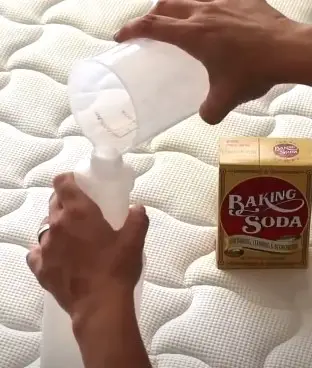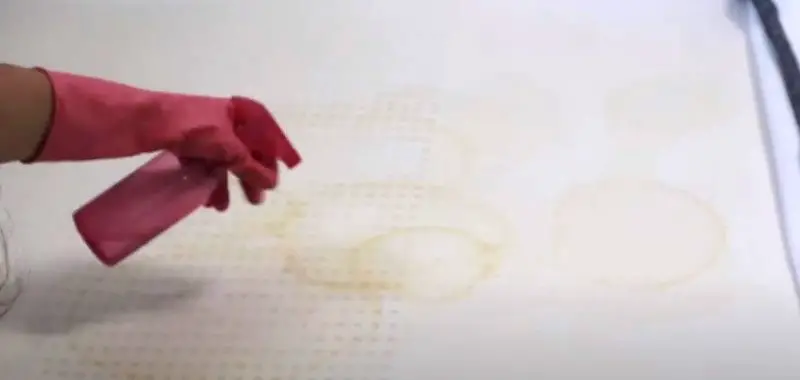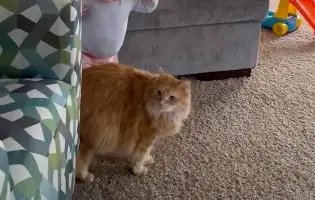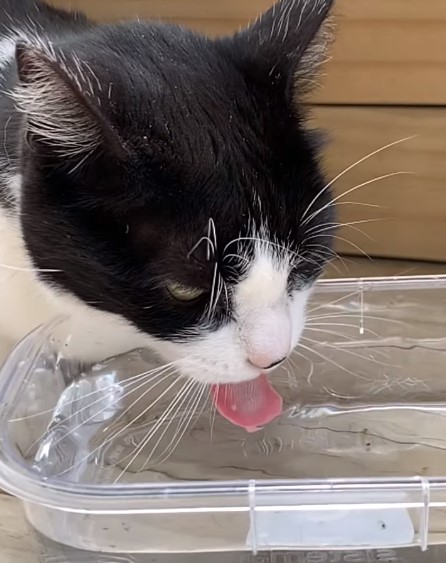Dealing with cat urine on your bed or mattress can be a frustrating and unpleasant experience. Whether it’s due to a behavioral issue or an accident, swift and effective action is necessary to eliminate the odor and stains.
In addition, the strong smell of cat urine can be difficult to remove and may cause you to lose sleep.
Though it may seem like a daunting task, removing cat urine from your bed is actually fairly simple. With a little time and effort, you can have your bed looking and smelling like new again.
How to Find Cat Urine With a UV Light
Finding cat urine with a UV (ultraviolet) light involves a simple yet effective process.
Purchase a handheld UV flashlight or blacklight designed for detecting pet stains. These lights emit UV-A light, which makes urine stains fluoresce in the dark.

Ensure the room is completely dark. Close curtains and blinds, and turn off any overhead lights. This darkness enhances the visibility of urine stains under UV light.
Turn on the UV light and hold it about 1-2 feet above the floor. Slowly scan the room, focusing on areas where your cat frequently goes, such as near the litter box, corners, or carpets.
Urine stains will appear as glowing spots or streaks under the UV light. They often emit a yellow or greenish glow, making them distinct from the surrounding area.
Under a black light, cat urine will glow because it contains phosphorus. This is a chemical that is known to absorb ultraviolet light, which is why it appears to glow under a black light.
As you identify urine stains, mark them with a piece of masking tape or chalk. This step is crucial for later cleaning and treatment.
Related: How to find where your cat peed?
How to Remove Cat Pee from a Mattress
Dealing with cat urine on a mattress can be a challenging and unpleasant task. However, with the right materials and a systematic approach, you can effectively remove the odor and stains.
Here’s a step-by-step guide on how to remove cat pee from a mattress:
What You’ll Need:
- Baking soda
- Clean towels
- Cold water
- Laundry detergent
- White vinegar
- Spray bottle
- Vacuum
The Process:

- Act Quickly: The sooner you address the issue, the better. As soon as you discover the urine stain, blot up as much liquid as possible using clean towels. Press down firmly to absorb as much moisture as you can.
- Prepare a Cleaning Solution: In a spray bottle, mix a solution of equal parts cold water and white vinegar. This solution is effective in neutralizing odors and breaking down urine enzymes.
- Spray and Blot: Liberally spray the affected area with the vinegar solution. Blot the area again with clean towels to remove more of the urine. Repeat this step until the towels no longer show discoloration.
- Apply Baking Soda: Generously sprinkle baking soda over the stained area. Baking soda helps to absorb any remaining moisture and neutralizes odors. Gently rub it into the mattress with a clean cloth or your fingers.
- Let It Sit: Allow the baking soda to sit on the mattress for at least 15-20 minutes, or longer if possible. This gives it time to work on any lingering odors.
- Vacuum: Use a vacuum cleaner with an upholstery attachment to thoroughly vacuum up the baking soda. Ensure that the mattress is completely dry before placing any bedding back on it.
- Wash Bedding: If your cat’s urine has soaked through the bedding, remove and launder it with cold water and a pet-safe laundry detergent. Avoid using hot water or strong detergents, as they can set the stain and odor.
By following these steps, you can effectively remove cat urine from your mattress, leaving it clean and odor-free. Remember to act quickly and be thorough in your cleaning process to achieve the best results.
How To Get Cat Pee Stains Out of a Mattress
Dealing with cat pee stains on a mattress can be frustrating, but with the right approach and a few household items, you can effectively remove the stains and odors.
Here’s a step-by-step guide on how to get cat pee stains out of a mattress using common items you probably already have.
What You’ll Need:
- Laundry detergent
- White vinegar
- Cold water
- Plastic wrap
- Towels
Steps to Remove Cat Pee Stains:
- Blot the Area: As soon as you discover the cat pee stain, blot the affected area with clean towels. Press down gently to absorb as much urine as possible. Avoid rubbing, as it can spread the stain.
- Prepare a Cleaning Solution: In a container, mix one part white vinegar with two parts cold water. This solution will help neutralize odors and break down the urine stain.
- Apply the Solution: Pour the vinegar and water mixture directly onto the stain. Ensure the affected area is well-saturated. Allow it to sit for about 10-15 minutes to penetrate the stain.
- Blot Again: Use clean towels to blot the area again, this time to remove the vinegar and water mixture. Press down firmly to absorb the liquid.
- Repeat if Necessary: If the stain and odor persist, you may need to repeat steps 3 and 4 until they are no longer noticeable.
- Dry the Mattress: Once the stain is gone, blot the area with clean, dry towels to remove as much moisture as possible.
- Use Plastic Wrap: To prevent moisture from seeping back into the mattress, cover the cleaned area with plastic wrap and place a heavy object on top. Leave it for a few hours to ensure thorough drying.
- Wash Bedding: While waiting for the mattress to dry, wash all bedding and linens that came into contact with the urine stain with cold water and laundry detergent.
By following these steps, you can effectively eliminate cat pee stains and odors from your mattress, leaving it clean and fresh for a good night’s sleep.
How To Get Cat Pee Smell Out of a Mattress
Discovering that your mattress has been soiled with cat pee can be distressing, but there’s a simple and effective way to tackle the lingering smell. With just two common household items – baking soda and a vacuum – you can say goodbye to that unpleasant odor.
What You’ll Need:
- Baking soda
- Vacuum
Steps to Get Cat Pee Smell Out of a Mattress:
- Blot the Area: If the cat pee is fresh, begin by blotting the affected area with clean towels. Gently press down to absorb as much moisture as possible. Avoid rubbing, as it may spread the urine.
- Sprinkle Baking Soda: Generously sprinkle baking soda over the entire stained area. Baking soda is renowned for its odor-absorbing properties and will help neutralize the cat pee smell.
- Let it Sit: Allow the baking soda to sit on the mattress for at least 15-30 minutes. During this time, it will work to absorb the odor.
- Vacuum Thoroughly: Use a vacuum cleaner with an upholstery attachment to thoroughly vacuum up the baking soda. Ensure that you cover the entire area, including any crevices or folds in the mattress.
- Repeat as Needed: If the odor persists, you may need to repeat the process a second time. This will depend on the severity of the odor and the freshness of the cat pee.
By following these steps, you can effectively eliminate the cat pee smell from your mattress, leaving it fresh and odor-free. It’s a simple and budget-friendly solution to ensure a peaceful night’s sleep.

Is Your Cat Peeing On Bed? 6 Reasons Why
Cats are known for their mysterious behavior, and one of the most frustrating issues cat owners can face is when their beloved feline starts peeing on the bed. This unexpected and unwelcome behavior can leave pet owners bewildered, concerned, and even frustrated.
As a responsible pet owner, it’s essential to understand that there are various reasons why your cat might be engaging in this behavior. Let’s see below some case study:
Stress and Anxiety – The Silent Culprits
Case Study 1: Olivia’s Story Olivia, a devoted cat owner, shares her experience of discovering her cat, Whiskers, urinating on her bed. She recounts the stressful changes in their household that may have triggered this behavior. We explore how stress and anxiety can affect cats and lead to inappropriate urination.
Medical Issues – When Health is at Stake
Case Study 2: Mark’s Story Mark’s cat, Luna, had always been well-behaved until she started urinating on his bed. Mark recounts his journey to find the root cause, which turned out to be an underlying medical condition. We discuss common health issues that can lead to inappropriate urination and the importance of regular veterinary check-ups.
Territory and Dominance – The Need to Mark
Case Study 3: Sarah’s Story Sarah, a cat enthusiast, shares her struggle with her two cats, Simba and Nala, who constantly marked their territory by urinating on her bed. We explore the concept of territorial behavior and how to manage a multi-cat household effectively.
Litter Box Problems – The Importance of Hygiene
Case Study 4: Michael’s Story Michael noticed that his cat, Bella, had stopped using the litter box and started using his bed instead. He discusses the critical aspects of litter box maintenance and how neglecting it can lead to litter box aversion.
Also read: Are self-cleaning litter boxes worth It?
Changes in Routine and Environment – Adapting to New Realities
Case Study 5: Emma’s Story Emma, a cat lover, adopted a rescue cat named Max, who struggled to adjust to his new home and started urinating on her bed. We explore how changes in a cat’s routine or environment can trigger this behavior and strategies to help them adapt.
Behavioral Issues – Training and Modification
Case Study 6: Daniel’s Story Daniel’s cat, Leo, had behavioral issues that manifested as urinating on his bed. Daniel shares his journey of working with a professional cat behaviorist and implementing behavior modification techniques to resolve the problem.
Preventing Future Pee
To prevent your cat from urinating on your bed or mattress, it’s essential to exercise patience and follow these steps diligently to ensure your feline friend starts using the litter box correctly.
Sufficient Exercise

Cats with pent-up energy or anxiety are more likely to engage in inappropriate urination. To mitigate this, dedicate time each day to engage your cat in physical activities.
Play with interactive toys, use feather wands, or encourage them to chase a laser pointer for at least 30 minutes to one hour daily.
Choose the Right Litter Box and Litter
Selecting the proper litter box and litter is crucial to encourage your cat to use it consistently. Ensure the litter box is the appropriate size for your cat and positioned in a quiet, accessible location. Experiment with different types of cat litter to find the one that your feline friend prefers.
Keep the Litter Box Clean
Maintain the litter box‘s cleanliness by scooping waste at least once a day. Cats are more likely to avoid a dirty box, so regular cleaning is essential to promote proper usage.
Regularly Clean Bedding
Cats are drawn to urinate where they detect previous markings. Promptly wash your bedding in the washing machine after any accidents to eliminate odors and discourage your cat from returning to the same spot.
Make Problem Areas Unattractive
To deter your cat from urinating on your bed or mattress, take steps to make these areas less appealing. When not in use, cover the bed with a non-absorbent material like a shower curtain or aluminum foil. Cats dislike the texture and will be less inclined to urinate there.
Re-Define the Bed’s Purpose
Help your cat associate your bed with activities other than urination. Begin playing with your cat on the bed and providing treats in that area. This positive reinforcement will gradually change your cat’s perception of the bed, making it a place for playtime and meals rather than a restroom.
Conclusion
Successfully removing cat urine from your bed or mattress is essential not only for cleanliness but also for peaceful coexistence with your feline friend. By following the steps outlined in this guide, you can eliminate odors and stains effectively.
Remember, acting promptly and using the right cleaning techniques can help ensure a fresh, odor-free bed or mattress, creating a more comfortable environment for both you and your cat.
His professional interests include humane education, ethics, small animal behavior, and veterinary. As a pet lover from school life, having grown up with two cats and a dog. If he isn’t spending time with his friends and family, Justin enjoys traveling. Learn more about Justin here.


